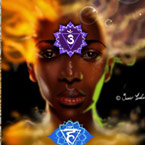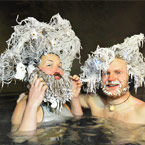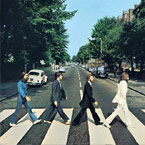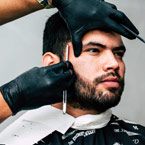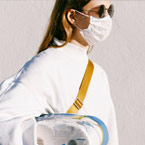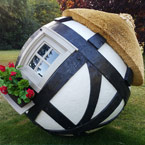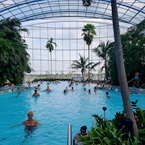Studio 58: Women Artists in Glasgow since WWII
Review and Interview by Emma Johnston,
Photographer Janet Wilson, Images Courtesy of The Glasgow School of Art
Note: The author's views are entirely his or her own and may not reflect the views of RetoxMagazine.com
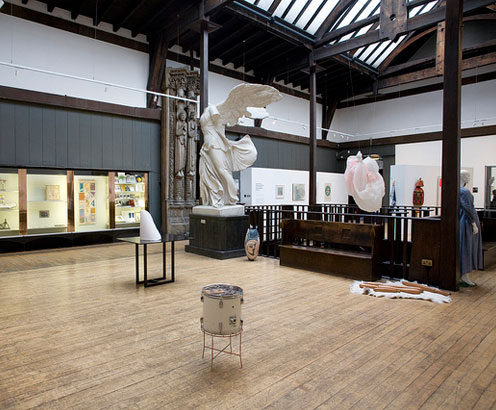
Studio 58: Women Artists in Glasgow since World War II.
Studio 58 - Glasgow School of Art
Learning the Art
I'll start this article by saying that art is not my fortes. I am a fan and enjoy visiting galleries and exhibitions, normally with some sort of guide or know it all friend. So rather than some specific arts correspondent for a high end newspaper, you have me. A filmmaking student trying to understand still images...
'Studio 58: Woman Artists in Glasgow since World War II' is the name of this exhibit and is simply a celebration of the art and other work of creative females past and present in Glasgow. The first part of the title refers to the area that was designated for female work space in the historical past of the impressive Glasgow School of Art building. Previously in 2010 there was the impressive 'Glasgow Girls' display which too delved into the work of female Glaswegian artists. This time round this exhibition has more on offer. Here we have over 100 pieces of art that is dedicated to the intense level of creativity present in Glasgow.
Assembling the Art
Curator Dr Sarah Lowndes spent two years assembling the display, and her passion behind it is certainly obvious. Her own background is heavily Glasgow based and her interest seems to be heavily focused on the story behind the art. This interest has paid off as it gives each item an individual attractive quality.
I spoke to Dr Lowndes via email and got to pick her brain a little.
Why have you chosen this specific time period for the exhibition, and in turn why is it so important for it to be female artists?
I chose to focus upon the work of women artists in Glasgow since World War II for a number of reasons. A few years ago, Jenny Brownrigg, Director of Exhibitions at GSA, invited me to curate an exhibition for the Mackintosh Museum. I have worked as a lecturer in the school for 10 years and I know it very well, the history and resonances of the building were important to me and to the staff and students. An exhibition for this space had to make some meaningful connection with the history of the building and its use. There had been two earlier exhibitions examining the work of the 'Glasgow Girls' who studied and worked in the school up until the 1930s, but no similar survey of women artists in the World War II years and beyond. I am very interested in social history, and in particular histories of people who may have been marginalised or excluded, so I decided to research the work of women artists who had studied and/or taught at the school since 1939, who I felt may not have received the attention they deserved. There are so many talented women artists who are not well known, for a combination of reasons, amongst them the inequality that exists in the collecting and exhibiting policies of galleries and museums, and the difficulties inherent in balancing work and family life.
How important is it for the artists to be from Glasgow?
All of the artists in the exhibition either studied or taught at Glasgow School of Art, and many did both. Also, all of the living artists whose work is included in the show are still resident in the Glasgow area. The reason for this was to reflect their investment and commitment to the art school and the city of Glasgow itself, and to use the space of the Mackintosh Museum as a way of thinking through some tendencies that are apparent in work made by Glasgow artists, for example the interest in process-based, performative practices seen in the work of artists including Jacki Parry and Karla Black or the interest in landscape and still life, traced through generations of artists from Margot Sandeman and Joan Eardley, to contemporary artists like Cathy Willkes and Zara Idelson.
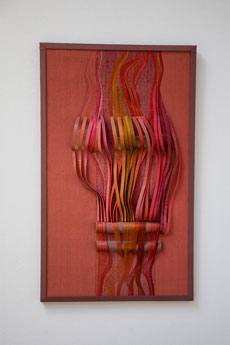
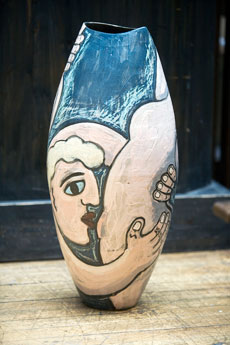
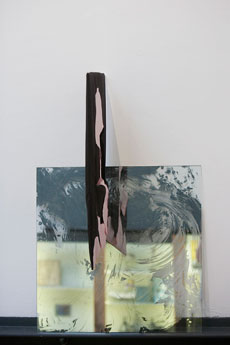
Studio 58: Woman Artists in Glasgow since World War II. Pictured from left to right: Hannah Frew Paterson, Karraree Fire (1970); Julie Henderson, Vase (late 1980s); Claire Barclay, Suspect Depth (2012).
Is it similar to other projects you have undertaken? If so why the interest and if not why have you chosen this path?
This is the most ambitious project that I have curated, with 54 artists in the show, 19 of whom are no longer living. Previously I have loaned works from the World Cultures collection of Glasgow Museums to show alongside the work of contemporary artists for the group show Votive (CCA, 2009), as I am interested in the dialogue that can occur between works of art from different time periods and cultural reference points, when viewed through a overarching theme. However, for Studio 58, myself and the Exhibitions Office at GSA worked with several public lenders including Glasgow Museums, the Hunterian Museum, Glasgow Women's Library, Glasgow School of Art Library and the Archives and Collections Centre at Glasgow School of Art, as well as borrowing works from a number of private collections, so that process was much more involved. I also felt a greater responsibility with this exhibition to be as balanced and as objective as possible in terms of the works I included, so that the exhibition represented different approaches, periods and styles whilst hopefully remaining coherent from a visual and thematic point of view.
Do you have personal favourite piece? What qualities do you enjoy in it?
I find it difficult to single out one work as I feel very close to many of the pieces in the show and the artists who have made them, and appreciate them all in different ways. Many of the works had either not been shown before or not displayed for a very long time. That was very emotional, especially when the sons, daughters, nieces and nephews of the dead artists said how happy they were to see the work of their mother or their aunt being admired after a period of silence. I also loved the correspondences between the works, for instance the lovely play between the colours and shapes of Karla Black's polythene cloud work, Now, At The Latest (2012) and Nita Begg's 1950's Still Life oil painting.
How does the art in the exhibition personally resonate with you?
I work as a writer, lecturer and curator. But I am also a wife and mother. I appreciate the difficulties that many of the artists in this show may have encountered while they tried to continue working as artists. I also really appreciate the opportunity to tell some of their stories, through the exhibition, and the accompanying catalogue, which will be published in September.
How was the 3 year process of gathering and organising the artwork?
The whole process has been wonderful, fascinating and really rewarding.
And finally
What do you think is attractive to the public about this exhibition?
Judging by comments left in the visitor's book, people feel this exhibition is overdue, and that the quality and variety of the work really merits closer scrutiny. Contemporary culture fixates on the new - but in this exhibition we can see there is much still to learn from the past.
The collection is incredibly eclectic and composes of many different styles and variations of art. This includes craft, painting and textiles. Each piece acts as a representation for its time period and reflects the social circumstances surrounding it. What is especially interesting are the many varied yet distinctive depictions of the female character, behaviour and lifestyle. The smooth transition between post war and contemporary seems effortless. Despite the small floor space, the layout of the exhibit allows for the spectators to get lost in the artwork easily as they move from piece to piece.
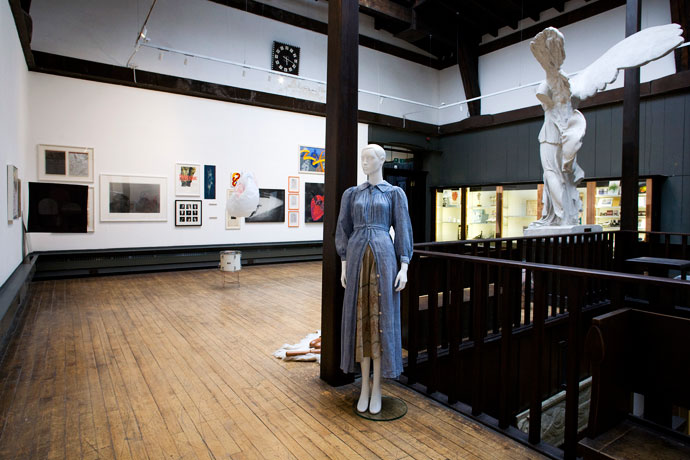
Studio 58: "Woman Artists in Glasgow since World War II" exhibition.
Enjoying the Art
One of the most interesting areas I found was an original glass cabinet for the building. This cabinet has not been seen in around 15 years as they are normally hidden under a false wall. Inside the cabinet there were publications, sculptures, scrapbooks and other extraordinary objects from Glaswegian females, of course celebrating their views and expressions to the world.
Personally speaking I found myself attracted to some pieces more than others. These were the works of Adele Patrick (1986 fashion piece) Annette Heyer (2005/12 material based) and Victoria Morton (1995 oil) I found their work evoked strong messages and helped me understand their train of thought. The display of different and overlapping generations is also interesting as it creates contrasting styles which give the exhibit yet more distinction and originality that make it desirable.
Share the Art
There is a lot on offer in this exhibition and there is something for everyone within. It allows for observers to understand what goes on before the brush strokes the canvas and acts as a reminder to celebrate the diversity of art available in the city. In short, it is an enjoyable learning experience and will open new eyes to different levels of culture.

